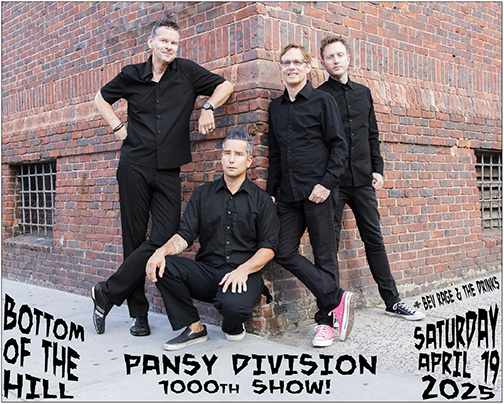
“We noticed about a decade ago that reaching 1,000 shows was achievable,” says vocalist/guitarist Jon Ginoli of PANSY DIVISION. “A band needs a goal, and that became ours.” On April 19, 2025, the legendary punk band will reach that goal of their 1,000th show at San Francisco’s Bottom of the Hill (1233 17th Street in San Francisco).
Tickets to celebrate with the band are available at
https://www.stubmatic.com/bottomofthehill/event/11204
Trailblazers not only in the punk world but especially in the LGBTQIA+ mainstream landscape, Pansy Division first began in 1991 when Ginoli and bassist/vocalist Chris Freeman surveyed the burgeoning rock scene and noticed a lack of openly queer musicians. To remedy that, they formed the band to fill in that void in San Francisco. “I’d had the idea to have an out gay rock band before I moved to California, but it took living in San Francisco to make it a reality,” Ginoli says. “So playing the 1,000th show in SF is bringing it back to the source.”
In the 34 years since the band’s inception in 1991, the band has moved from the Pacific northwest for other climes, but their love of their origin city remains. “Although SF was our birthplace, the sad fact is that the SF that birthed us with cheap apartments and rehearsal spaces is long gone… and so are we,” he sighs. “I was the last to leave in 2022. But we all still love SF and there was no question where we’d play our 1,000th show there. That we get to do it at Bottom of the Hill, where we have played so many times over the past 30 years, is both appropriate and exciting!”
Considered “queercore legends” by Rolling Stone, Pansy Division hurled open the closet door when they started at the start of the ‘90s. Marrying melodic and infectious indie rock with a hyper-aware queer identity and a sex-positive message, they attracted both a gay and mainstream audience, including fellow artists such as Willie Nelson, Rob Halford of Judas Priest (who was inspired by the band to come out of the closet) and Green Day who took the band out to support them on their Dookie tour in 1994.
Three decades plus later, their trailblazing has never been more fully realized: the music scene has grown exponentially more accepting of LGBTQ+ artists to the point that it’s almost dizzying. “There is so much of it now that I can’t keep track of it, and that’s a far cry from when we were starting out,” Jon says. “If more people had been out then, especially in rock, we might not have felt the need to start this band in the first place. But there wasn’t, so we did, and being so open, unapologetic, blunt and fun about it means that it still resonates today.”
